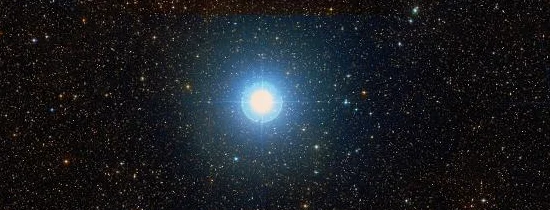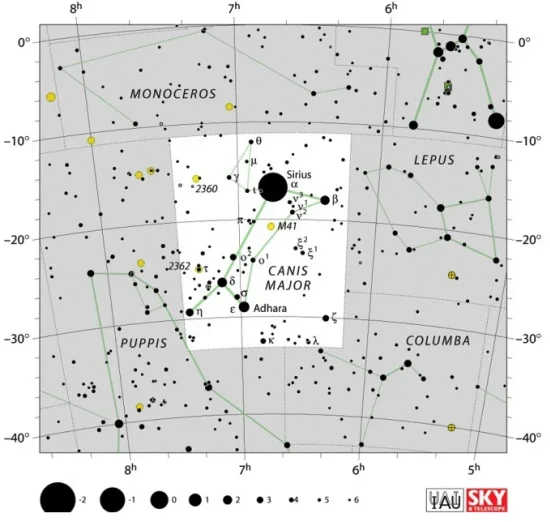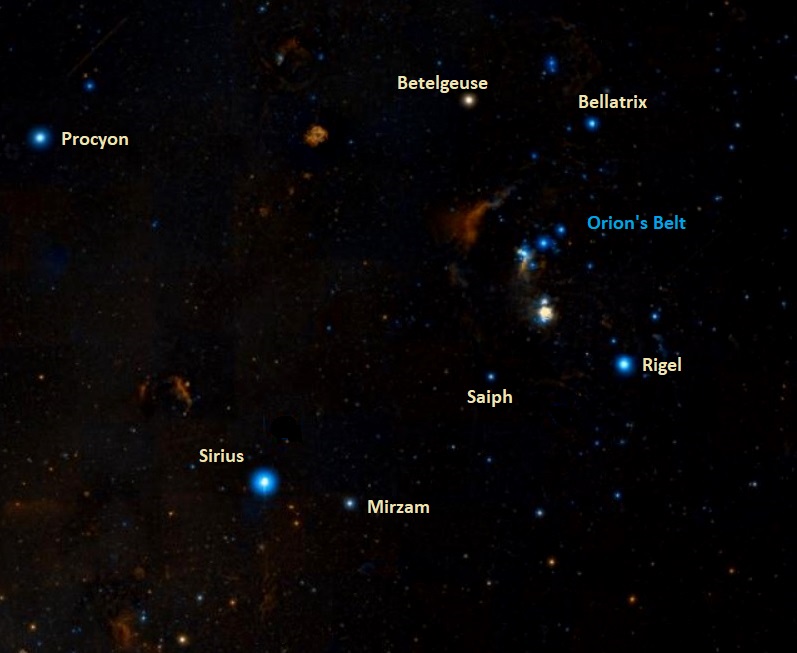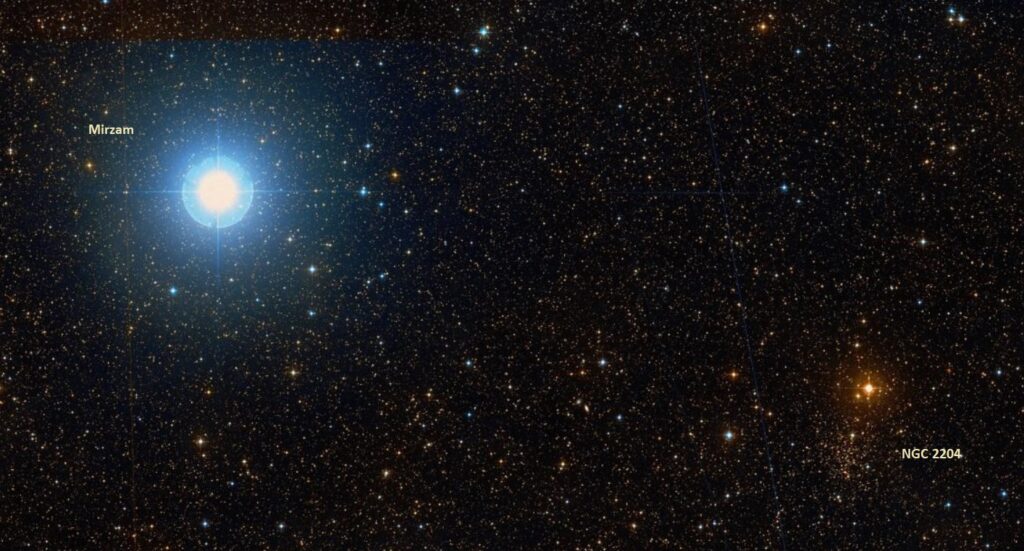Mirzam, Beta Canis Majoris (β CMa), is a blue-white giant or bright giant star located in the constellation Canis Major. With an average apparent magnitude of 1.985, it is the fourth brightest star in Canis Major, after Sirius, Adhara, and Wezen. Mirzam lies at an approximate distance of 490 light years from Earth.
Star type
Mirzam is a young star of the spectral type B1 II-III. The stellar classification indicates a giant or bright giant appearing blue-white in colour.
The star has a mass 13.5 times that of the Sun and, as it evolved away from the main sequence, it has expanded to a size of 9.7 solar radii. With a surface temperature of 23,150 K, Mirzam is 26,600 times more luminous than the Sun, but most of its output is in the invisible ultraviolet. The star’s projected rotational velocity is about 31 km/s.
Even though Mirzam is very young, with an estimated age of 12.4 million years, like all massive stars, it has evolved quickly and will not live a very long life. It is currently expanding and cooling, and will eventually become a red giant or supergiant. With a mass of 13.5 solar masses, when it reaches the end of its lifecycle it will not go quietly. Instead, it will meet its end as a brilliant supernova.

Mirzam (Beta Canis Majoris), image: Wikisky
Mirzam is classified as a Beta Cephei variable. Its brightness varies between magnitude +1.97 and +2.01 with a period of about 6 hours. The amplitude of the variations is too small to be noticed by the unaided eye.
Also known as Beta Canis Majoris stars, Beta Cephei variables are typically hot blue class B stars that show small rapid changes in their brightness due to pulsations of their surfaces. Named after the blue-white subgiant Alfirk (Beta Cephei), these stars typically show variations in brightness by 0.01 to 0.03 magnitudes over a period of 2.4 to 7.2 hours (0.1 to 0.3 days). The group includes many bright stars, among them Hadar (Beta Centauri), Mimosa (Beta Crucis), Imai (Delta Crucis), Spica (Alpha Virginis), Epsilon Centauri, Alpha Lupi, Alpha Muscae, Algenib (Gamma Pegasi), Epsilon Persei, Shaula (Lambda Scorpii), Kappa Scorpii, and Alniyat (Sigma Scorpii).
Facts
Mirzam was the brightest star in the sky from 4,460,000 years ago to 3,700,000 years ago. It reached a maximum magnitude of -3.65 about 4,420,000 years ago, when it came within 37 light years of the solar system. For comparison, Sirius shines at magnitude -1.46. Of all the historical brightest stars, only Adhara shone brighter than Mirzam, at magnitude -3.99. Mirzam was preceded by Adhara as the brightest star and succeeded by Canopus, currently the second brightest star in the sky.
Mirzam is one of the 27 bright stars that are featured on the flag of Brazil. Each star represents a Brazilian Federative Unit and Mirzam symbolizes the state of Amapá.
Name
The name Mirzam (pronunciation: /ˈmɜːrzəm/) comes from the Arabic Al-Murzim, meaning “the herald.” It refers to the star’s rising just before Sirius. The name has also been spelled as Murzim and Mirza.
The name was approved by the International Astronomical Union’s (IAU) Working Group on Star Names (WGSN) on July 20, 2016.
In Arabic astronomy, Mirzam and Gomeisa (Beta Canis Minoris) were known as Al Mirzamani, “the heralds,” or as Al Mirzama al Shi’rayain, “the heralds of Sirius.”
In Chinese astronomy, Mirzam is known as 軍市一 (Jūn Shì yī), the First Star of Market for Soldiers. The Market of Soldiers is a Chinese asterism formed by Mirzam with Nu3 Canis Majoris, 15 Canis Majoris, Pi Canis Majoris, Omicron1 Canis Majoris and Xi1 Canis Majoris. The asterism is part of the Well mansion, one of the southern mansions of the Vermillion Bird. The Chinese also know Mirzam as Kuen She. The name is a derivation from 軍市一 (Jūn Shì yī).
In the Tuamotu Archipelago, the star was called Oupo.
Location
Mirzam is very easy to find because it lies in the vicinity of Sirius, the brightest star in the sky. Sirius is easy to identify both because it is exceptionally bright and because it has a prominent asterism, the Belt of Orion, pointing directly at it. A line extended from Mintaka, the westernmost star of Orion’s Belt, through Alnilam and Alnitak, leads in the direction of Sirius. Mirzam is located just southwest of Sirius.
Mirzam can be used to find the open cluster NGC 2204. The cluster is fairly bright and large, with an apparent magnitude of 8.6 and an apparent size of 13’. It lies at a distance of 8,600 light years from Earth.
Constellation
Mirzam is located in the constellation Canis Major, the Greater Dog. It marks the dog’s front leg or paw. Canis Major is the 43rd constellation in size, occupying an area of 380 square degrees. Best known for being home to Sirius, the brightest star in the sky and one of our nearest neighbours, Canis Major has been familiar to observers since ancient times. It is one of the 48 Greek constellations, first listed by the astronomer Claudius Ptolemy of Alexandria in the 2nd century CE. It represents the larger dog following Orion, the Hunter. The smaller dog is represented by the neighbouring constellation Canis Minor.

Canis Major constellation map by IAU and Sky&Telescope magazine
Canis Major contains a number of notable stars, including the bright Sirius, the red hypergiant VY Canis Majoris, one of the largest known stars, and the bright supergiants Wezen and Aludra. Bright deep sky objects in the constellation include the open clusters Messier 41, NGC 2360 (Caroline’s Cluster) and NGC 2362 (the Tau Canis Majoris Cluster), the Canis Major Dwarf, the closest neighbouring galaxy to Earth, the colliding galaxies NGC 2207 and IC 2163, and the emission nebula NGC 2359, nicknamed the Thor’s Helmet Nebula.
Canis Major lies in the southern sky and can be seen in its entirety from locations south of the latitude 60° N. The best time of year to observe the stars and deep sky objects in the constellation is during the month of February, when the constellation is prominent in the evening sky.
The 10 brightest stars in Canis Major are Sirius (Alpha CMa, mag. -1.46), Adhara (Epsilon CMa, mag. 1.50), Wezen (Delta CMa, mag. 1.824), Mirzam (Beta CMa, mag. 1.985), Aludra (Eta CMa, mag. 2.45), Furud (Zeta CMa, mag. 3.025), Omicron2 Canis Majoris (mag. 3.043), Unurgunite (Sigma CMa, mag. 3.43 – 3.51), Kappa Canis Majoris (mag. 3.40 – 3.97 ), and Omicron1 Canis Majoris (mag. 3.78 – 3.99).
Mirzam – Beta Canis Major
| Spectral class | B1II-III |
| Variable type | Beta Cephei |
| U-B colour index | −0.99 |
| B-V colour index | −0.235 |
| Apparent magnitude | 1.985 (1.97 – 2.01) |
| Absolute magnitude | -4.1 |
| Distance | 490 ± 20 light years (151 ± 5 parsecs) |
| Parallax | 6.62 ± 0.22 mas |
| Radial velocity | +33.70 ± 0.5 km/s |
| Proper motion | RA: −3.23 ± 0.19 mas/yr |
| Dec .: −0.78 ± 0.20 mas/yr | |
| Mass | 13.5 ± 0.5 M☉ |
| Luminosity | 26,600 L☉ |
| Radius | 9.7 ± 1.3 R☉ |
| Temperature | 23,150 K |
| Metallicity | 0.04 ± 0.10 dex |
| Age | 12.4 ± 0.7 million years |
| Rotational velocity | 31 ± 5 km/s |
| Surface gravity | 3.79 ± 0.20 cgs |
| Constellation | Canis Major |
| Right ascension | 06h 22m 41.9853527s |
| Declination | −17° 57′ 21.307352″ |
| Names and designations | Mirzam, Murzim, Beta Canis Majoris, β CMa, 2 Canis Majoris, HD 44743, HR 2294, HIP 30324, SAO 151428, GC 8223, GCRV 4051, FK5 243, BD − 17 ° 1467, CCDM 06227-1757A, ALS 15801, EUVE J0622-17.9, IDS 06183-1755 A, IRAS 06204-1755, 2MASS J06224199-1757215, PLX 1481, PPM 217099, TYC 5938-2918-1, WDS J06227-1757A |

